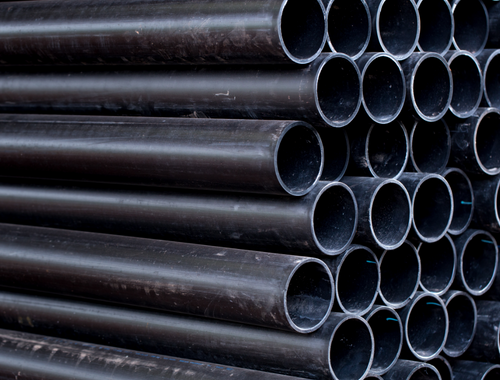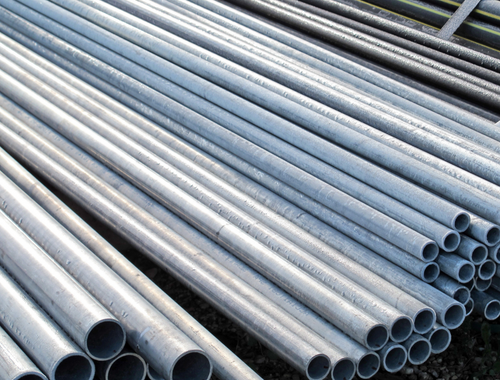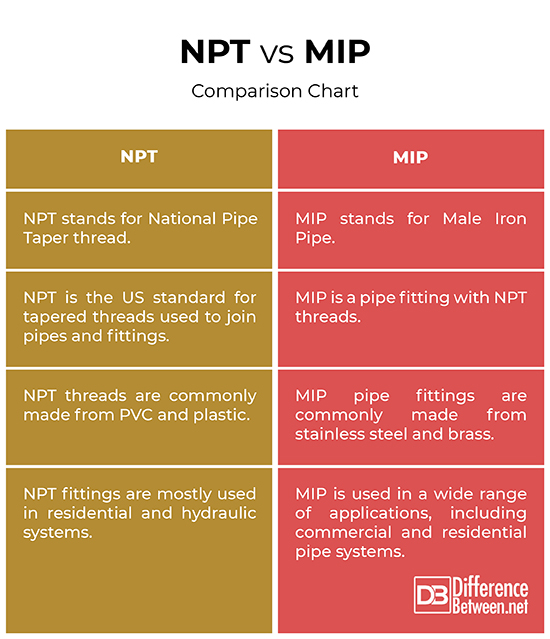Difference Between NPT and MIP
All pipes are connected with fittings, which allow connection of pipes along a straight run, called couplings. There are different types of fittings used to connect pipes, like 90 degrees couplings or elbows, 45 degrees angles, T fittings, and a wide range of other formats. In PVC, often slip fittings are used which are glued together. Some fittings are threaded which are called threaded fittings. These are screwed into compatible connecting fittings in pumps or other plumbing works. The NPT standard is most commonly used in the United States for many different applications such as pumps, fuel systems, regulators, filters, and so on. The MIP is also used interchangeable with the NPT.

National Pipe Taper (NPT)
NPT, or National Pipe Taper, is a US standard for tapered threads used for joining pipes and fittings. It is an American standard thread on malleable iron pipes, which have a slight taper. The NPT standard includes a slight tapering between the male and female connections. Fittings with male (external) threads are often referred to as MPT (Male Pipe Thread) or MNPT (Male National Pipe Thread), and those with female (internal) threads are called FTP (Female Pipe Thread) or FNTP (Female National Pipe Thread). An American businessman and mechanical engineer, William Sellers invented a uniform system of screw threads which later became the NPT standard in 1864. The most common material used is iron and brass, which are commonly used for low pressure applications whereas stainless steel and carbon are mostly used for high pressure applications.

Male Iron Pipe (MIP)
MIP, or Male Iron Pipe, is one of the two commonly used components in heavy duty threaded pipe connections. Male iron pipe, as the name suggests, is a pipe wit threads on the outside, such as a pipe nipple. FIP (Female Iron Pipe) fittings, however, has threads on the inside. MIP is a pipe fitting with NPT threads and is commonly made of stainless steel and brass. Although the name says iron, MIP fittings are not always made of iron. If one side of the fitting is MIP and other side in FIP, it’s usually called mip by slip. MIP fittings are mainly used in conjunction with FIP fittings is many different ways in commercial, residential and industrial piping systems. They are used in heavy duty applications such as high pressure pipe systems or natural gas carrying pipes. A couple of different materials are used to make MIP fittings depending on application areas.
Difference between NPT and MIP
Fitting
– NPT refers to both internal and external threads on fittings that conform to the ANSI/ASME B1.20.1 standard pipe threads. National Pipe Thread Tapered, or NPT is the US standard for tapered threads used to join pipes and fittings. MIP, on the other hand, is the acronym for male iron pipe and is a pipe fitting with NPT threads. MIP refers to fittings with male threads and FIP describes fittings with female threads.
Material
– NPT threads are commonly made from PVC and plastic whereas MIP pipe fittings are commonly made from stainless steel and brass. Other materials are also used for MIP fittings such as iron, copper, PVC, plastic, and so on. Metal pipes with threads are much durable and sturdier than the non-threaded ones. Thus they can withstand accidental damage and chances of pipe wear and tear from daily use are less. Plastic threads are relatively less durable and are more prone to leaks.
Applications
– NPT fittings are mainly used for low pressure applications like residential pipe systems and hydraulic systems. Many industries use NPT fittings for sealing pipes for gas and fluid transfer. They are used in a wide range of pressure sensitive applications, ranging from electrical conduits to high pressure pipes that carry natural gas and chemically aggressive liquids. MIP pipes are used in high pressure applications in a variety of industries as well as in residential pipe systems.
NPT vs. MIP: Comparison Chart

Summary
In a nutshell, NPT is the defined standard for pipe fittings regulated by the American National Standards Institute (ANSI) and is approved for use in residential and commercial piping systems. But many people NPT and MIP interchangeably. MIP is a pipe fitting with NPT threads. Fittings with male threads are called MIP whereas fittings with female threads are called FIP. NPT and MIP work together but do not mate with any other type of fitting. NPT fittings are mostly used in residential and hydraulic systems, and male iron pipe is used in a wide range of applications, including commercial and residential pipe systems.
Can you connect NPT to MIP?
NPT and MIP work together but do not mate with any other type of fitting. They have similar thread dimensions, so both the fittings are interchangeable.
Is MIP fitting tapered?
MIP threads are not tapered. There is no tapering on either side of the pipe.
Is MIP and MPT the same?
MIP stands for male iron pipe whereas MPT stands for male pipe thread. Both are pipe fittings with NPT threads. MPT is a sub type of NPT and MPT/FPT and NPT threads are not compatible.
Are MPT and NPT threads compatible?
No. MPT and NPT threads are not compatible.
What is a MIP fitting?
MIP is a pipe fitting with NPT threads. Fittings with male threads are called MIP and fittings with female threads are called FIP.
What does MIP mean in plumbing?
MIP is one of the major components in heavy duty threaded piping connections. MIP has threads on the outside and a FIP fitting has threads on its inside like a T fitting.
- Difference Between Caucus and Primary - June 18, 2024
- Difference Between PPO and POS - May 30, 2024
- Difference Between RFID and NFC - May 28, 2024
Search DifferenceBetween.net :
 Email This Post
: If you like this article or our site. Please spread the word. Share it with your friends/family.
Email This Post
: If you like this article or our site. Please spread the word. Share it with your friends/family.
Leave a Response
References :
[0]Hart, Eric. The Prop Effects Guidebook: Lights, Motion, Sound, and Magic. Oxfordshire, United Kingdom: Routledge, 2017. Print
[1]Bunker, Jordan. PVC and Pipe Engineer: Put Together Cool, Easy, Maker-Friendly Stuff. Massachusetts, United States: Rockport Publishers, 2018. Print
[2]Cauldwell, Rex. Plumbing. Connecticut, United States: Taunton Press, 2007. Print

